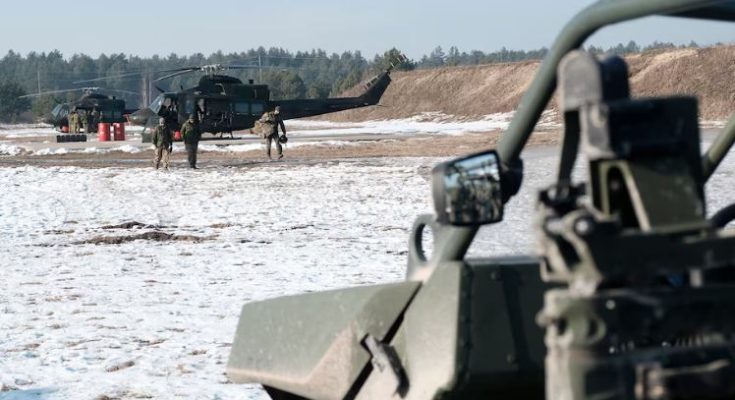ADAZI BASE, Latvia — In a forest in Latvia, just 150 miles from the Russian border, Swedish soldiers crouch among the trees, their faces smeared in green and black paint, posing as invaders against a combined force of Canadian, Spanish and Italian soldiers, among others.
That commitment, which forms the backbone of NATO, no longer seems to be shared at the highest levels of government in founding member America.
On Thursday, President Donald Trump reiterated his long-standing criticism of NATO members, claiming they weren’t spending enough on their defense. He again suggested that the United States would not defend some member countries if they were attacked — the fundamental premise of the alliance under Article 5 of its charter.
“If the United States was in trouble, and we called them, we said, ‘We got a problem, France. We got a problem, couple of others I won’t mention.’ Do you think they’re going to come and protect us? They’re supposed to. I’m not so sure,” he said in the Oval Office.
The officers at the NATO exercise near Latvia’s Adazi military base declined to talk about recent U.S. remarks about the alliance but said the exercise showed that the alliance is ready to deter Russia and respond with military force in case of an attack.
“Obviously, Russia demonstrated that they can illegally cross a border and attack another country,” said Col. Cédric Aspirault, the Canadian brigade commander in Latvia, adding that his brigade was well equipped to halt any attack.
“It’s not just about the amount of people or the amount of tanks you have. It is the quality that you have, and the equipment that every country has brought forward here is exceptional,” he said, adding that all NATO assets would be ready to support and protect Latvia in case of attack.
As a direct result of Russia’s actions in Eastern Europe, including invading Ukraine first in 2014 and then again in 2022, NATO beefed up its presence in the eight nations on NATO’s eastern flank, setting up multinational battle groups. The Multinational Brigade in Latvia consists of 3,500 troops from 13 nations, commanded by Canada — another country that has recently been in the crosshairs of Trump’s foreign policy.
The tone from the White House toward its European allies, however, has been quite dismissive, with Vice President JD Vance expressing doubt that European troops stationed in Ukraine could deter Russia — a proposal made by France and Britain.
“That is a way better security guarantee than 20,000 troops from some random country that hasn’t fought a war in 30 or 40 years,” he said, talking about a U.S. deal for Ukraine’s mineral wealth. The remarks provoked outrage among the many European countries that fought alongside U.S. troops in Afghanistan and Iraq.
Washington’s wavering on its NATO commitments has stoked alarm among its European allies, and on Thursday, European Union members announced an unprecedented military buildup based on the premise that they could no longer rely on the United States.
Since invading Ukraine, Russia has portrayed itself as being in an existential battle against the “collective West,” because of NATO’s support for Kyiv in its fight against Russia. But now, pro-Kremlin media increasingly refer to Europe and Britain as the “Old World,” reinforcing the message that Russian President Vladimir Putin is midwifing a new world order with the United States.
“Putin has, for quite some time now, been trying to sort of dismantle the structures and the institutions of Western power because he finds them to be limiting,” said Sam Greene, a professor in Russian politics at King’s College London. As a transactional politician eager to do deals, Trump, he said, shares Putin’s desire to weaken or dismantle NATO and other Western institutions.
The emerging parameters of the U.S. peace deal — locking Ukraine out of NATO and enabling Russia to retain the Ukrainian territory it seized, with no U.S. participation in security guarantees — would offer Putin much of what he wants.
A Russian victory, Greene said, would not only be disastrous for Europe’s security but would also harm U.S. interests and set off land grabs around the world.
“If we enter a world in which actually launching a war to change the borders of a neighboring country is shown to be effective and thus acceptable, then it likely doesn’t stop at Russia and China, right? There’s lots of biggish countries that are neighboring smallish countries and might like bits and pieces of their territory,” he said, adding that it would likely set off arms races around the world.
Andrea Kendall-Taylor, director of the Transatlantic Security Program at the Center for a New American Security, described Trump as having switched sides away from Europe and toward Russia, and said she feared that the United States would render the alliance inoperable, leaving its remaining members vulnerable to Russian attack. Europe would be particularly exposed in coming years, as it scrambles to ramp up defenses and military production.
“If the United States withdraws from NATO and remove sanctions on Russia and allows them to reconstitute their military more quickly, there will be at least a 10-year period where Europe is at maximum vulnerability and where, given what we know about Putin’s intent to fully destroy NATO and increase his own influence over Europe, he would be very tempted to invade a NATO member.”



